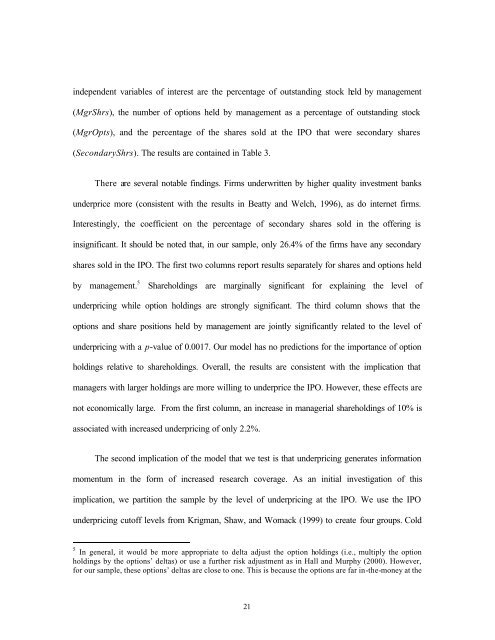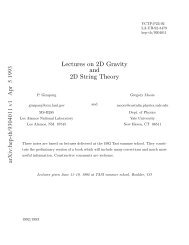Strategic IPO underpricing, information momentum, and lockup ...
Strategic IPO underpricing, information momentum, and lockup ...
Strategic IPO underpricing, information momentum, and lockup ...
Create successful ePaper yourself
Turn your PDF publications into a flip-book with our unique Google optimized e-Paper software.
independent variables of interest are the percentage of outst<strong>and</strong>ing stock held by management<br />
(MgrShrs), the number of options held by management as a percentage of outst<strong>and</strong>ing stock<br />
(MgrOpts), <strong>and</strong> the percentage of the shares sold at the <strong>IPO</strong> that were secondary shares<br />
(SecondaryShrs). The results are contained in Table 3.<br />
There are several notable findings. Firms underwritten by higher quality investment banks<br />
underprice more (consistent with the results in Beatty <strong>and</strong> Welch, 1996), as do internet firms.<br />
Interestingly, the coefficient on the percentage of secondary shares sold in the offering is<br />
insignificant. It should be noted that, in our sample, only 26.4% of the firms have any secondary<br />
shares sold in the <strong>IPO</strong>. The first two columns report results separately for shares <strong>and</strong> options held<br />
by management. 5<br />
Shareholdings are marginally significant for explaining the level of<br />
<strong>underpricing</strong> while option holdings are strongly significant. The third column shows that the<br />
options <strong>and</strong> share positions held by management are jointly significantly related to the level of<br />
<strong>underpricing</strong> with a p-value of 0.0017. Our model has no predictions for the importance of option<br />
holdings relative to shareholdings. Overall, the results are consistent with the implication that<br />
managers with larger holdings are more willing to underprice the <strong>IPO</strong>. However, these effects are<br />
not economically large. From the first column, an increase in managerial shareholdings of 10% is<br />
associated with increased <strong>underpricing</strong> of only 2.2%.<br />
The second implication of the model that we test is that <strong>underpricing</strong> generates <strong>information</strong><br />
<strong>momentum</strong> in the form of increased research coverage. As an initial investigation of this<br />
implication, we partition the sample by the level of <strong>underpricing</strong> at the <strong>IPO</strong>. We use the <strong>IPO</strong><br />
<strong>underpricing</strong> cutoff levels from Krigman, Shaw, <strong>and</strong> Womack (1999) to create four groups. Cold<br />
5 In general, it would be more appropriate to delta adjust the option holdings (i.e., multiply the option<br />
holdings by the options’ deltas) or use a further risk adjustment as in Hall <strong>and</strong> Murphy (2000). However,<br />
for our sample, these options’ deltas are close to one. This is because the options are far in-the-money at the<br />
21

















